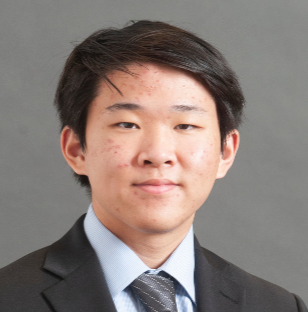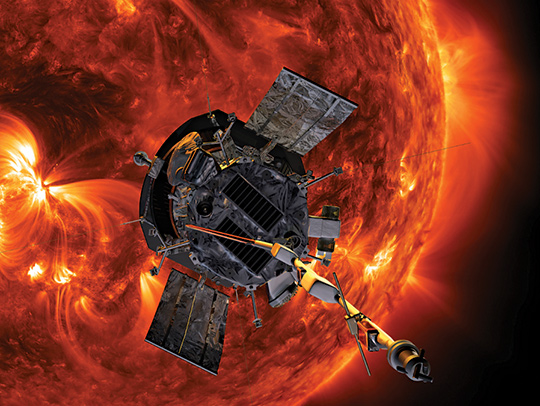- Details
-
Category: Department News
-
Published: Wednesday, September 11 2024 05:24
For students interested in experimental research, there is no substitute for performing experiments in a lab. Working in a lab is invaluable for picking up important skills and learning if a research area is a good fit.
For senior physics and mathematics double major Patrick Chen, who plans to pursue experimental physics in the future, UMD has provided ample opportunities for hands-on experience. Throughout his time at UMD, Chen has taken the initiative to work outside his classes and get practical lab experience. This summer an endowed undergraduate award allowed Chen to further expand that experience by funding his travel to Oak Ridge National Laboratory (ORNL) in Tennessee. At the lab, he bombarded samples with neutrons from a nuclear reactor in experiments he had previously only been able to simulate.
“I always enjoyed hands-on stuff,” Chen said. “I was really compelled to want to see what it's actually like doing the experiments and whether that's something I actually like, as well as to learn about the process and see what it's like to travel to these facilities to go do work.”
The trip provided Chen with practical experience using lab equipment that requires large, specialized facilities—like a nuclear reactor. It also gave him a broader perspective on the reality of being an experimental physicist. The insights and experiences come at a critical time as Chen begins his senior year and considers his options for graduate school and professionally pursuing physics.  Patrick Chen
Patrick Chen
Chen’s opportunity to visit ORNL was built on a foundation of research experience that he has been establishing throughout his time at UMD. He got an early start exploring research. The summer before his freshman year, he came to campus early and participated in UMD’s Toolkit for Success program. The program, run by Donna Hammer, the physics director of education, and Angel Torres, the physics outreach coordinator, helps students build skills and explore career options through physics and math lessons, a research project and meetings with professionals from industry, government, and academia.
“I think that program is really great, but also after coming to UMD, Angel and Donna have been incredibly helpful if I have any questions or need anything,” Chen said. “They're always there for me and they've been very helpful during my time here at UMD in navigating the physics department and making me aware of opportunities.”
During Chen’s freshman year, he kept an eye out for more opportunities to get research experience. He attended a department event where members of several labs presented their research to students. The work being performed in the lab of Nick Butch, an Adjunct Associate Professor of physics at UMD and a Physicist at the NIST Center for Neutron Research, caught Chen’s attention, and Butch welcomed Chen into the lab when he reached out. Initially, Chen mainly served as an extra pair of hands around the lab, assisting with activities like processing data that labmates had collected and programming the heating cycles on the furnaces used to fabricate materials.
Eventually, Butch created a project for several undergraduate students to work on as a group, aiming to provide them with experience in the research area of condensed matter physics, which he specializes in. The topic deals with how particles, particularly electrons, interact to produce the emergent properties of a material, and classes on condensed matter are generally taught at the graduate level, which can make it tricky for undergraduate students to explore an interest in the topic.
“We make our own materials, so the benefit of having undergrads work on that kind of research is that it doesn't actually necessarily require a lot of physics classroom knowledge to get started,” Butch said. “The way that I have it set up, we don't necessarily have the students sitting and doing heavy analysis that is requiring a lot of mathematics or anything like that.”
In the project, the students make a variety of material samples themselves and then measure the properties of the materials. Since the students work as a group and individuals can come and go, it gives them a chance to explore condensed matter research, without the hassle of starting a project from scratch or experiments being left unfinished if they’re a bad fit for a particular student. Chen and a few of his classmates have kept the project going over the past couple of years, and by working together they can schedule around their classes and steadily maintain progress improving the processes, making new materials and refining their measurement skills.
“Patrick is a wonderful student,” Butch said. “I look forward to seeing impressive things from him in the future.”
When Chen started looking for summer research opportunities in 2023, Butch encouraged him to apply to the Summer Undergraduate Research Fellowship (SURF) at NIST, which is supported by the Center for High Resolution Neutron Scattering. Chen did, and the program accepted him. He was assigned to work with NIST Instrument Scientist Jonathan Gaudet who works at the NIST Center for Neutron Research. Gaudet gave Chen a project exploring the magnetic behaviors of materials called Weyl semimetals.
When studying Weyl semimetals and other materials, researchers, like Gaudet, often rely on neutron scattering experiments to study the material. In the experiments, researchers shoot neutrons through a material, which provides them with an up-close image of the structure of materials—kind of like a microscope.
But unlike a microscope that uses visible light, neutron scattering doesn’t just provide an image of the surface. Neutrons can pass through solid objects without much chance of interacting since they don’t have an electrical charge—meaning they don’t interact with the outer shell of electrons of an atom and must hit the much smaller target of the nucleus to interact. If researchers send enough neutrons into a material, a few will collide and be deflected from their original path. Researchers can analyze where the deflected neutrons are sent to determine the hidden structure they interacted with inside the material.
Unfortunately, the NIST Center for Neutron Research is in the middle of an extensive repair and upgrade project, so the equipment for performing neutron scattering experiments has been unavailable for use. Since Chen couldn’t perform measurements at NIST to observe the structure of real Weyl semimetals, he had to pursue an alternative method of investigation—simulating the materials on a computer.
Chen’s efforts last summer produced a simulation that he used to predict how neutrons would scatter through Weyl semimetals. But Chen still wanted to perform real neutron scattering experiments himself. So, he was interested when Gaudet mentioned an upcoming trip to ORNL that Chen could join. However, to take the opportunity, Chen had to cover his travel expenses. He applied for a College of Computer, Mathematical, and Natural Sciences Alumni Network Endowed Undergraduate Award and obtained the necessary funding. He was one of only nine students from across the entire College of Computer, Mathematical, and Natural Sciences to receive funding through the program this year.
With the money, Chen was able to join the trip to ORNL in Tennessee as part of his fellowship this summer. There, he got to experience the culture of a new laboratory and was finally able to perform the neutron scattering experiments that he’d spent the last summer studying through a computer program. He helped perform measurements on Weyl semimetals for his own project as well as other projects from Gaudet’s lab.
Not everything went smoothly. Gaudet had time reserved to use three different machines at the lab, and technical issues sprung up on two of the machines—one wouldn’t cool down properly and another had a mechanical malfunction. So before getting experience running the experiments, Chen got a taste of troubleshooting equipment on a fixed schedule.
“Sitting at a computer looking at either generated data or gathered data, that's not actually like dealing with the machines breaking down, figuring out what can we do since we lost time because we had to fix the machines and things like that,” Chen said. “I think having done this once now, it's really helped me to understand a lot more how the instruments actually work and given me a better understanding of the process, which has helped me better contextualize and understand the data I have been working with.”
With those insights and new experimental data in hand, Chen is ready to move on to the next step of research: analyzing the data and sharing it with the rest of the research community. Chen’s initial analysis of the data he collected, as well as data from other experiments, validates his project from last summer.
“Patrick’s simulations led to several predictions, which could be verified with neutron scattering experiments,” Gaudet said. “He carried out such neutron experiments this summer at the Oak Ridge National Laboratory and successfully confirmed his predictions. The success of his project speaks to Patrick's motivation, curiosity, and ability for science, which I hope he will pursue further.”
During his last year at UMD, Chen plans to apply to graduate programs in physics and to continue working with Gaudet to write a paper on his research project to submit to an academic journal.
“I enjoyed the experience immensely, both for being able to gather the data and see all the stuff and do all the experiments as well as getting the chance to travel to the Smoky Mountains,” Chen said. “If I do end up continuing with condensed matter in grad school, neutron scattering is something that's probably pretty likely that I'll be using, so getting this experience now is really valuable.”
Story by Bailey Bedford

